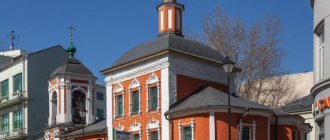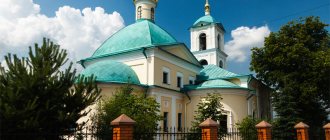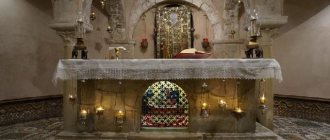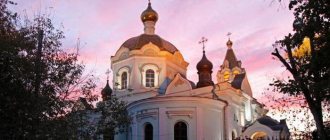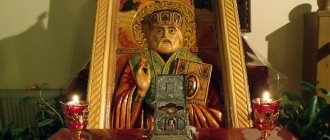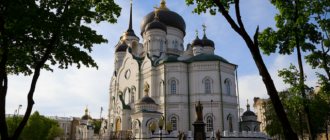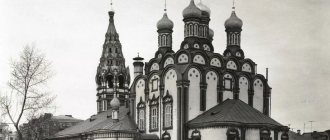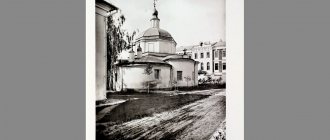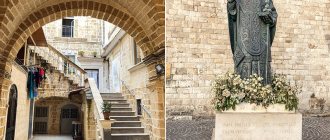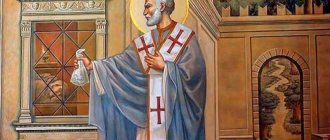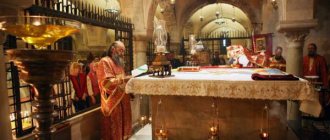The patriarchal merchant world of Zamoskvorechye is unthinkable without religion. Since the second half of the 15th century, massive construction of churches and temples took place here. The magnificent churches of St. Nicholas in Pyzhi, Gregory of Neocaesarea, the Resurrection in Kadashi and other masterpieces of temple art related to the ancient Orthodox direction of the Old Believers were erected here.
Patriarch Joachim blessed the decision to build a brick Church of St. Nicholas, instead of a wooden one
Time passed, the settlement grew, the blacksmiths were actively engaged in fishing and trading. When the settlement grew to two hundred households, with the blessing of Joachim, Patriarch of Moscow, in 1681, the construction of a brick temple began to replace the dilapidated wooden church.
The renovated temple had one chapel and a refectory, and a bell tower was built nearby. In two years, a five-domed structure with kokoshniks in several tiers was erected. Windows were made only in the central drum of the temple, but the extensions were solid, blank.
The stone temple of St. Nicholas the Wonderworker in Kuznetskaya Sloboda, built according to the design of one of M.F.’s students. Kazakov in the 19th century and has survived to this day
At the beginning of the 19th century, the current stone church of St. Nicholas was built in Kuznetsy
The St. Nicholas Church served faithfully for 160 years, until, at the beginning of the 19th century, the clergy decided to renovate the building.
Some historians claim that the architect of the modern Church of St. Nicholas was Matvey Kazakov himself. The same architect who, during the reign of Catherine, planned and renovated the central part of Moscow in the Palladian style of early classicism.
Others insist that the construction was carried out according to the design of one of Matvey Fedorovich’s students.
Soon a refectory with two chapels and a large, three-tiered bell tower were built, and in 1895 the main iconostasis was completely renewed.
The three-tier bell tower of the temple, built with a stone building in 1842. The brick predecessor had only 2 tiers
It is noteworthy that during the turbulent years of revolutions, wars and even during the Soviet period, the Church of St. Nicholas in Kuznetsy was among the few surviving and operating religious institutions. People even said that during the Bolshevik rule, a distant relative of Vladimir Ilyich Lenin worked in this church.
Shrines and valuables from destroyed churches were brought here.
In 1992, the St. Nicholas-Kuznetsk Church became the main one for St. Tikhon's Humanitarian University, located next to the church. And in 2013, Patriarch Kirill of Moscow consecrated the main and Sergius chapels.
The Church of St. Nicholas the Wonderworker has a baptismal house, an Orthodox university and a gymnasium
The Church of St. Nicholas the Wonderworker is located in the Central Administrative District of Moscow, in the Zamoskvorechye district.
Its main chapel is consecrated in honor of St. Nicholas the Wonderworker of Myra, the southern one - St. Sergius of Radonezh. The northern aisle was built in the name of the Holy Martyr Basil of Amasia, and after the introduction of the icon of the Most Holy Theotokos into the temple, it was reconsecrated in her honor. However, the feast day of St. Basil remained the patronal feast day of the parish.
In 2013, Metropolitan Kirill of Moscow consecrated the main chapel and the chapel of St. Sergius of Radonezh in the Church of St. Nicholas the Wonderworker of Myra in Zamoskvorechye
The temple is single-domed with many windows, which makes it bright and cozy, despite the severity of the architectural forms and bas-reliefs.
A baptismal house with a large marble font was built on the territory and consecrated in honor of Equal-to-the-Apostles Prince Vladimir. Baptismal ceremonies and educational conversations are held here.
The ensemble is complemented by a large bell tower, the chapel of St. Tikhon, the building of the Orthodox Humanitarian University, and the Traditional St. Peter's Gymnasium.
Architecture and decoration of the building
Appearance
The Church of St. Nicholas the Wonderworker was built in the Empire style, with one dome. In the round niches above the northern and southern entrances there are bas-reliefs of the apostles - two above each. The flow of the plane of the walls of a small room to the wide funnel of the dome gives the impression of spaciousness, “openness”, aspiration to a bright world. Excellent interior lighting contributes to this. Through the triple windows of the drum, wide streams of light pour in: the gilded stucco decorations of the iconostasis stand out, and the silver color of the dome painting with the image of the Holy Trinity is emphasized.
Interior design
The church is in excellent condition both inside and outside. Thanks to the large windows, the inside of the building appears spacious and well-lit. The interior decoration is very modest and simple, there is no pomp in it, which is why there is a cozy atmosphere in which anyone feels like they are in a large Orthodox family. Anyone can visit the temple; the priests who serve there are kind and fair.
This church is considered one of the most holy places in Moscow.
Shrines
The main shrine is considered to be the miraculous icon of the Mother of God - “Assuage my sorrows.” Thanks to this shrine, many miracles happened. The icon helps desperate people in healing bodily ailments and getting rid of sins and temptations. Touching and tender prayers gave the name to this wondrous icon.
The icon depicts the Mother of God holding with her right hand the Infant Christ, in whose hands a scroll is unfolded with the words: “Judge righteous judgment, do mercy and generosity to everyone who is sincere; Do not force a widow or an orphan, and do not create malice in your brother’s heart.” The left hand of the Mother of God is attached to her head tilted to one side, as if she is listening to the prayers of those turning to her.
The Mother of God asks for the Christian before the Lord, and he receives the desired support. Many events were accomplished by her. One case is described. A sick, dying woman saw the image of the Mother of God in a dream. She asked to be taken to the temple. But no such icon was found. The priest opened all the storerooms, and among the dusty icons the woman finally saw the image she had dreamed of. She could barely raise her hand and cross herself. After the prayer service, venerating the icon, the sick woman stood up and walked.
Previously, the Image of the Virgin Mary was in the Church of St. Nicholas in Sadovniki, and after the revolution it was moved for permanent storage to Kuznetsy.
Feast of the Miracle-Working Icon - January 25
Other shrines of the temple:
- icon of the Mother of God “Seeking the Lost”;
- icon of St. Nicholas the Pleasant and his life;
- Iveron Icon of the Mother of God;
- icon of St. Alexis.
Schedule of services
Anyone can attend the church and services.
The rector of the temple is Archpriest Vladimir Nikolaevich Vorobyov.
Services are held at:
- weekdays 8:00 - mass;
- Sunday and holidays at 7:00, 9:00 mass;
- weekdays and holidays - 17:00 evening service.
Water is blessed on Thursdays.
Sunday School
The church runs a Sunday school for children of different ages. First, preparatory work is carried out with the children. The lesson lasts one hour. Children over 6 years old study for one and a half hours. Lessons are structured in a playful manner. In addition to the Law of God, the school teaches choral singing, lessons in the Church Slavonic language and creative arts lessons. School students can eat in the refectory.
In the summer, since 1991, the Orthodox tent camp “Bogoslovo” has been operating for children. Children in the camp are under the supervision of priests and not only play and have fun, but also work for the benefit of the camp. The temple also carries out social and educational work, provides assistance to large families and single elderly people.
The church has a school for adults, an Orthodox humanities university, and classes on the study of the Holy Scriptures, as well as conversations for those wishing to be baptized.
How to get there
You can get to the temple, located in the very heart of Zamoskvorechye, not far from the Paveletskaya metro station (at the address: Vishnyakovsky lane, 15):
- from Art. metro station "Paveletskaya", "Novokuznetskaya" by tram 3, 39, A, stop " Vishnyakovsky Lane";
- from Art. metro station "Kitai-Gorod", "Okhotny Ryad", "Kuznetsky Most" by bus M 5, stop " Stary Tolmachevsky Lane".
Servants of the Church of St. Nicholas teach Sunday school and organize pilgrimages
The church has organized a free Sunday school for both children and adults, where anyone can learn the Word of God, choral singing, comprehend the Bible,
Boys and girls from 13 to 25 years old participate in youth choir classes at the Sunday school of the Nikolo - Kuznetsk Church
In the summer, the outgoing Orthodox camp “Bogoslovo” operates, the participants of which, mainly children and teenagers from low-income families, not only become spiritually enlightened, but also actively relax in the fresh air.
Pilgrimage trips to holy places are organized.
There is also an Orthodox St. Peter's traditional gymnasium, where, along with Theology, general education disciplines are taught. Upon completion, students receive state certificates.
There is also a so-called family church, where they teach parents family values, playing out various worldly situations, from a biblical point of view.
Social assistance to low-income and large families has been organized and is being successfully developed. There is an emergency assistance team.
Current state
Now, the temple is in excellent condition inside and out, anyone can visit it. The atmosphere in this parish is very friendly, all parishioners are treated with respect, the priests serve kindly but fair.
Church of St. Nicholas in Kuznetskaya Sloboda
On the territory of the church there is a free Sunday school for children of all ages, where lessons are given in the Church Slavonic language, the law of God, choral singing and creative activities. Sunday school students can eat in the church refectory.
Attention! Every summer, children go to an Orthodox tent camp, where they are under the supervision of priests, perform daily prayers, work for the benefit of the camp, poor families and elderly people living in the area, play and have fun in the clean air.
Also, the temple operates a school for adult parishioners, and missionary and pilgrimage trips are made.
The list of shrines of the Church of St. Nicholas is headed by the icon of the Most Holy Theotokos “Quench My Sorrows”
The list of the icon of the Mother of God was transferred by the Church of St. Nicholas in Sadovniki during the October Revolution. Many miracles happened, from the healing of illnesses to deliverance from temptations thanks to her. The patronal feast day in honor of the miraculous icon is held on January 25 and February 7.
The icon “Quench My Sorrows” decorated with flowers and lamps during the patronal feast day in the Nikolo-Kuznetsky Church in Moscow
Another of the revered shrines is the icon of the Most Holy Mother of God “Seeking the Lost.” According to some reports, it was in front of this icon that Mikhail Yuryevich Lermontov composed the poem “The Wanderer’s Prayer.” The patronal memory of the icon in the Church of St. Nicholas in Kuznetsy is celebrated on February 18.
A great number of miracles are accomplished thanks to the icon of St. Nicholas the Pleasant of Myra and his life, which represent an equally important shrine of the temple in Kuznetskaya Sloboda. The icon is venerated three times a year: December 6, May 22 and August 11. Festive events are held on these days.
The next important shrine, whose throne is celebrated on February 26, May 6 and October 26, is the list of the Iveron Mother of God. Mother protects the hearth and intercedes for the needs of the Orthodox before her Son, our Lord. The original icon is located in a monastery on Mount Athos, where no woman has ever set foot.
The icon of Saint Alexis laying a cross on Saint Sergius is also celebrated.
The interior decoration of the temple is in perfect harmony with the architecture of early classicism
History of the foundation of the temple
Saint Nicholas is a saint revered throughout the Christian world. He is famous for his good deeds during his life and miracles after he was canonized. Saint Nicholas the Wonderworker is the patron saint of disadvantaged people, widows, warriors, orphans and travelers. Many churches in Rus' are dedicated to the saint and wonderworker.
Church of St. Nicholas in Kuznetskaya Sloboda
The foundation of the Moscow Church of St. Nicholas dates back to the 15th century, along with the appearance of the Kuznechnaya Settlement, where blacksmiths lived. The first wooden church building on this site was made in 1491, which was replaced by a brick building in 1683 with the blessing of the patriarch. The first mention of this parish can be found in documents from 1625.
About other temples:
- Epiphany Cathedral (Elokhovsky)
- Church of the Nine Martyrs of Kizichesk in Moscow
- Temple of the All-Merciful Savior in Mitino
In 1805, the building was renovated with money collected from parishioners. Since the church was already very dilapidated, the building was dismantled, and in its place a stone church appeared, which can be seen in our time. The new building was built in the Empire style, according to the design of the famous architect M.F. Kazakova. A beautiful bell tower, consisting of three tiers, and a refectory were added to the main building in 1847. The new refectory is large, with its own altar in honor of the Entry of the Holy Mother of God into the temple.
The interior decoration of the temple is modest and simple, there is no pomp in it , which is why there is a cozy atmosphere in which you feel like you are in a large Orthodox family.
Inside, the building appears spacious and very well lit thanks to large triple windows.
Interesting! In the post-revolutionary period, the temple remained open and services were held in it. The entire district was surprised by such a miracle; there were rumors that a relative of V.I. was working at the temple. Lenin.
In 1991, a separate baptismal house was built with donations in honor of the name of St. Prince Vladimir. The house hosts christenings of adults and children in a marble font.
